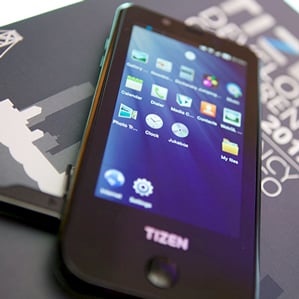Samsung’s Tizen Will Hit the Ground Running with Android Apps
If app availability is the make-or-break factor in the success of any smartphone operating system, then Tizen—the secrecy-cloaked OS that Samsung is expected to unveil on a new device this month at Mobile World Congress in Barcelona—could leap from the gate fairly strongly.

A few well-publicized app-writing contests have already led to more than 6,000 apps crafted specifically for Tizen. And new technology will allow it to run huge numbers of existing apps written for Google’s Android operating system, which powers the majority of the world’s smartphones. “At a minimum we will be providing tens of thousands of apps able to run on the Tizen platform, and we’ve had discussions that go up into the hundreds of thousands,” says Howie Hecht, director of product management and content platforms for OpenMobile. The company, based in Framingham, Massachusetts, makes an application compatibility layer that will let existing Android apps run on Tizen devices.
He stopped short of explaining how users would get the apps, but Samsung is expected to open a Tizen app store after launching its Tizen smartphone.
By developing its own operating system rather than relying almost entirely on Android, Samsung hopes to give users a unified experience on devices ranging from phones and netbooks to in-vehicle systems and smart TVs.
It is too soon to predict that Tizen will do better than other Android alternatives: Microsoft’s Windows Phone and the BlackBerry OS have picked up only a tiny percentage of the global smartphone market (see “New Mobile OSs May Mean the End of the Closed App Store”). A few others are trying to break into the low end of that market through strategies such as putting the Firefox OS on cheap phones that emphasize Web-based apps (see “The Underdog Operating Systems Set to Shake Up the Smartphone Scene”).
Samsung, which did not reply to a request for comment for this story, is a special case: it is the world’s leading smartphone maker and also the main user of Android. If Tizen becomes a credible alternative to Android, it could threaten Google’s long-term ability to continue steering users to Google products and gathering the data that fuels the Google advertising juggernaut.
Although Google and Samsung recently signed a major cross-licensing deal for intellectual property, a successful launch of Tizen would be the start of a major departure for Samsung and change the dynamics of its symbiotic relationship with Google. Tizen grew out of Nokia’s MeeGo platform and is now being developed by an industry consortium led by Samsung and Intel.
People experience phones largely through their favorite apps, not the underlying operating system. The leading app stores, Apple’s App Store and Android’s Google Play, each have more than a million, a milestone they passed last year. And that huge lead is part of the reason the Windows Phone OS hasn’t taken off and the BlackBerry OS has all but collapsed.
So while last year the consortium behind Tizen held a series of developer challenges with incentives totaling $4 million to develop a few thousand apps, it was understood that this was not enough to compete. That’s why Samsung sought to make far more existing Android apps available to its new phone using OpenMobile’s technology.
Another factor in Tizen’s favor: numerous companies now make software known as “middleware” that was not available when Android and Apple’s iOS launched. It lets a writer create a new app once, then click a few buttons to put that app in various app stores, ready to run on several operating systems.
Brian Warner, project lead for Tizen at the Linux Foundation, which promotes open-source projects based on the Linux platform (as both Tizen and Android fundamentally are), cites an additional advantage. When the maker of a device also makes the software it will run, the performance can be optimized in ways that don’t happen with operating systems made to work on numerous models. “Keeping in mind it’s impossible to say what any commercial device will be like until it is revealed, I think performance will be a strong point for Tizen,” he says. “I’ve personally seen some apps that have just been incredible in terms of graphics and performance.”
Grzegorz Adamczyk, a developer in Poland, says he finds Tizen faster than Android when using graphics accelerators needed for the 3-D games he writes, which include a helicopter combat action game called FinalStrike3D. “In my opinion, Tizen is a very powerful platform for game development,” he says.
Keep Reading
Most Popular
Large language models can do jaw-dropping things. But nobody knows exactly why.
And that's a problem. Figuring it out is one of the biggest scientific puzzles of our time and a crucial step towards controlling more powerful future models.
The problem with plug-in hybrids? Their drivers.
Plug-in hybrids are often sold as a transition to EVs, but new data from Europe shows we’re still underestimating the emissions they produce.
How scientists traced a mysterious covid case back to six toilets
When wastewater surveillance turns into a hunt for a single infected individual, the ethics get tricky.
Google DeepMind’s new generative model makes Super Mario–like games from scratch
Genie learns how to control games by watching hours and hours of video. It could help train next-gen robots too.
Stay connected
Get the latest updates from
MIT Technology Review
Discover special offers, top stories, upcoming events, and more.